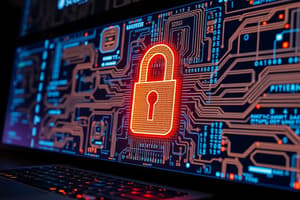Podcast
Questions and Answers
Explain what secrecy, confidentiality and privacy mean as the
cybersecurity goals.
Explain what secrecy, confidentiality and privacy mean as the cybersecurity goals.
Secrecy: Methods to restrict access to information (e.g., cryptography, access control). Confidentiality: Duty to protect others' secrets. Privacy: Right to control your personal information and space.
Explain what Iaas, Paas and Saas are give examples on how you would use them for you start up tech.
Explain what Iaas, Paas and Saas are give examples on how you would use them for you start up tech.
Infrastructure as a service provides scalable and automated computer resources for monitoring, networking and storage. I will use this to create virtual servers to store data and monitor them virtually and configure network so that the users can use it safely and efficiently. Platform as a service allows developers to implement and deliver applications within the cloud environment. This will help the developers in my company to focus coding without worrying about the infrastructure. Software as a service is using the cloud-based software with a subscription. This is for the non-coding employees, cloud based software will allow them to access their work materials anywhere they want or on any devices as long as they have internet. They can use collaborative apps and work more effectively.
Caution with Saas
Caution with Saas
A personal device cannot access on-premise resources but if that device gets hacked, the hacker could open their cooperate email, access the saas applications on the device to steal or destroy the company data and if the employee uses the same password for their personal and work email, it can lead to compromise through brute force or password guessing.
Explain what the Multifactor Authentication (MFA) is and provide an example.
Explain what the Multifactor Authentication (MFA) is and provide an example.
Explain what "Shadow IT" means and why it is problematic.
Explain what "Shadow IT" means and why it is problematic.
What could be the threat and counter measurement when data is at rest on the user's device or on the server's on-premise hard-drive or cloud server?
What could be the threat and counter measurement when data is at rest on the user's device or on the server's on-premise hard-drive or cloud server?
What could be the threat and counter measurement when data is in transit?
What could be the threat and counter measurement when data is in transit?
What are the top causes for the costliest data breach in an order?
What are the top causes for the costliest data breach in an order?
What is the process to perform a targeted attack?
What is the process to perform a targeted attack?
Explain the two metrics that evaluate the performance of the Red Team.
Explain the two metrics that evaluate the performance of the Red Team.
Explain the two metrics that evaluate the performance of the Blue Team.
Explain the two metrics that evaluate the performance of the Blue Team.
What does the Blue Team do when the Red Team is able to breach the system?
What does the Blue Team do when the Red Team is able to breach the system?



